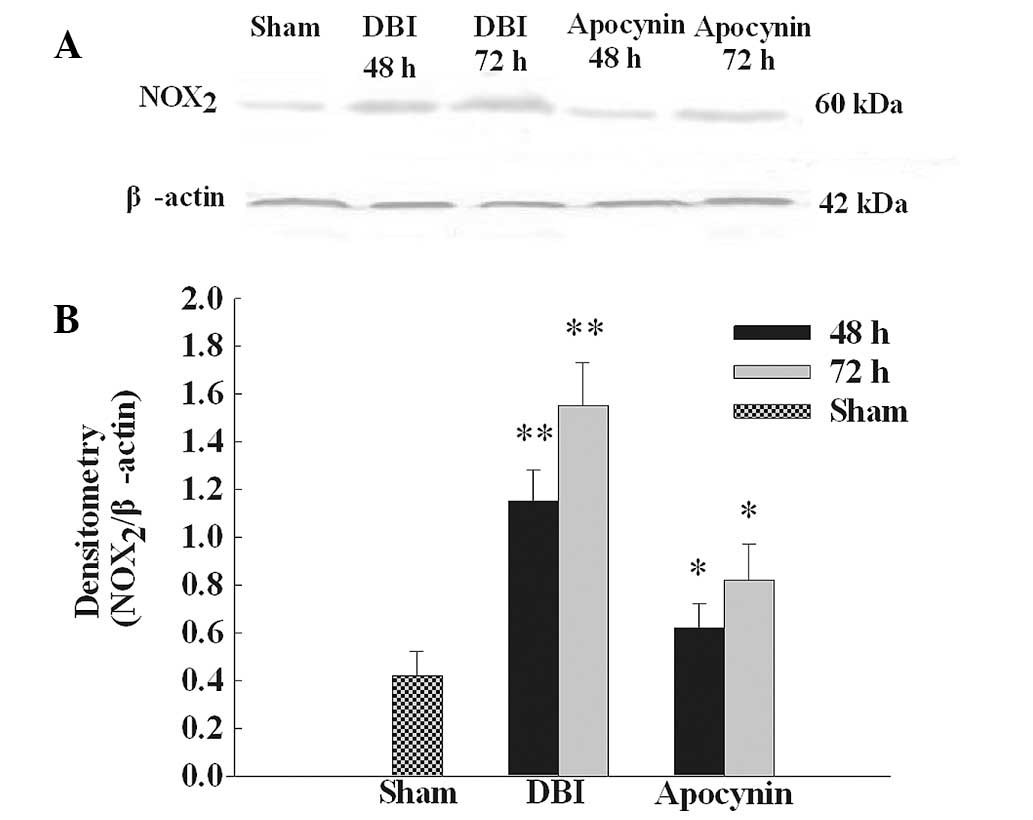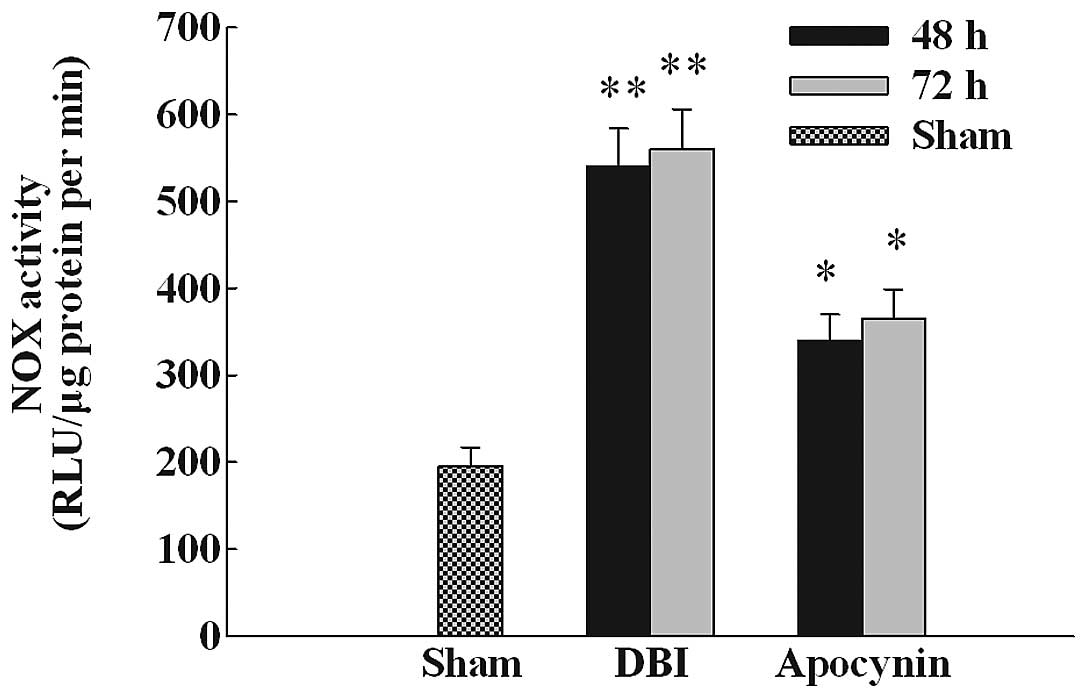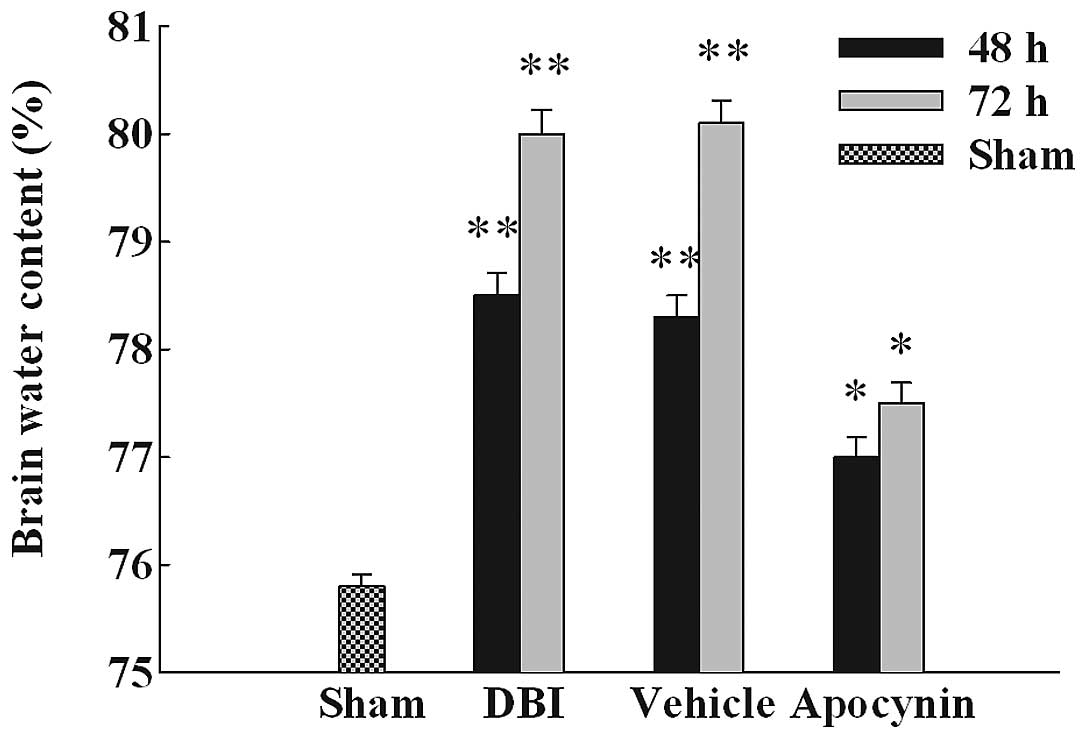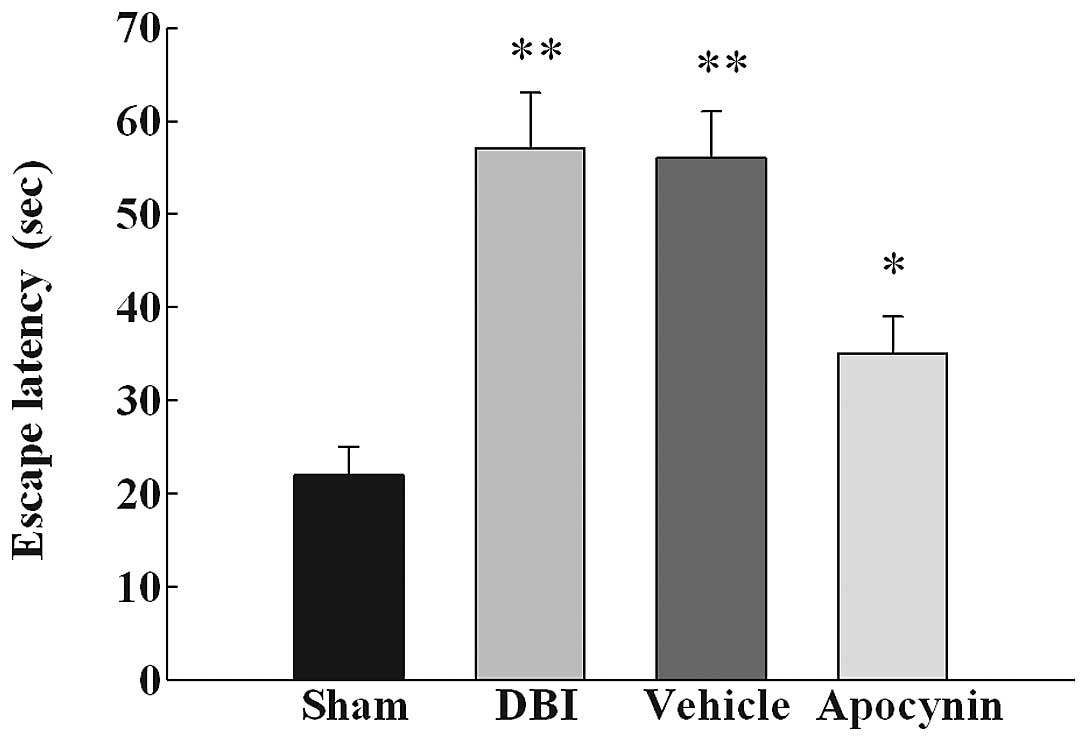|
1
|
Bedard K and Krause KH: The NOX family of
ROS-generating NADPH oxidases: physiology and pathophysiology.
Physiol Rev. 87:245–313. 2007. View Article : Google Scholar : PubMed/NCBI
|
|
2
|
Infanger DW, Sharma RV and Davisson RL:
NADPH oxidases of the brain: distribution, regulation and function.
Antioxid Redox Signal. 8:1583–1596. 2006. View Article : Google Scholar : PubMed/NCBI
|
|
3
|
Kim MJ, Shin KS, Chung YB, Jung KW, Cha CI
and Shin DH: Immunohistochemical study of p47Phox and gp91Phox
distributions in rat brain. Brain Res. 1040:178–186. 2005.
View Article : Google Scholar : PubMed/NCBI
|
|
4
|
Sorce S and Krause KH: NOX enzymes in the
central nervous system: from signaling to disease. Antioxid Redox
Signal. 11:2481–2504. 2009. View Article : Google Scholar : PubMed/NCBI
|
|
5
|
Serrano F, Kolluri NS, Wientjes FB, Card
JP and Klann E: NADPH oxidase immunoreactivity in the mouse brain.
Brain Res. 24:193–198. 2003. View Article : Google Scholar : PubMed/NCBI
|
|
6
|
Lafeber FP, Beukelman CJ, van den Worm E,
et al: Apocynin, a plant-derived, cartilage-saving drug, might be
useful in the treatment of rheumatoid arthritis. Rheumatology
(Oxford). 38:1088–1093. 1999. View Article : Google Scholar : PubMed/NCBI
|
|
7
|
Zhang Y, Chan MM, andrews MC, et al:
Apocynin but not allopurinol prevents and reverses
adrenocorticotropic hormone-induced hypertension in the rat. Am J
Hypertens. 18:910–916. 2005. View Article : Google Scholar : PubMed/NCBI
|
|
8
|
Sawauchi S, Marmarou A, Beaumont A, Tomita
Y and Fukui S: A new rat model of diffuse brain injury associated
with acute subdural hematoma: assessment of varying hematoma
volume, insult severity and the presence of hypoxemia. J
Neurotrauma. 20:613–622. 2003.
|
|
9
|
Kahles T, Luedike P, Endres M, et al:
NADPH oxidase plays a central role in blood-brain barrier damage in
experimental stroke. Stroke. 38:3000–3006. 2007. View Article : Google Scholar : PubMed/NCBI
|
|
10
|
Tang LL, Ye K, Yang XF and Zheng JS:
Apocynin attenuates cerebral infarction after transient focal
ischaemia in rats. J Int Med Res. 35:517–522. 2007. View Article : Google Scholar : PubMed/NCBI
|
|
11
|
Connell BJ, Saleh MC, Khan BV and Saleh
TM: Apocynin may limit total cell death following cerebral ischemia
and reperfusion by enhancing apoptosis. Food Chem Toxicol.
49:3063–3069. 2011. View Article : Google Scholar : PubMed/NCBI
|
|
12
|
Murillo MM, Carmona-Cuenca I, Del Castillo
G, et al: Activation of NADPH oxidase by transforming growth
factor-beta in hepatocytes mediates up-regulation of epidermal
growth factor receptor ligands through a nuclear
factor-kappaB-dependent mechanism. Biochem J. 405:251–259. 2007.
View Article : Google Scholar
|
|
13
|
Zhang QG, Raz L, Wang R, et al: Estrogen
attenuates ischemic oxidative damage via an estrogen receptor
alpha-mediated inhibition of NADPH oxidase activation. J Neurosci.
29:13823–13836. 2009. View Article : Google Scholar
|
|
14
|
Tang J, Liu J, Zhou C, et al: Mmp-9
deficiency enhances collagenase-induced intracerebral hemorrhage
and brain injury in mutant mice. J Cereb Blood Flow Metab.
24:1133–1145. 2004. View Article : Google Scholar : PubMed/NCBI
|
|
15
|
Hui-guo L, Kui L, Yan-ning Z and Yong-jian
X: Apocynin attenuate spatial learning deficits and oxidative
responses to intermittent hypoxia. Sleep Med. 11:205–212. 2010.
View Article : Google Scholar : PubMed/NCBI
|
|
16
|
Woodfin A, Hu DE, Sarker M, Kurokawa T and
Fraser P: Acute NADPH oxidase activation potentiates
cerebrovascular permeability response to bradykinin in
ischemia-reperfusion. Free Radic Biol Med. 50:518–524. 2011.
View Article : Google Scholar
|
|
17
|
Yoshioka H, Niizuma K, Katsu M, et al:
NADPH oxidase mediates striatal neuronal injury after transient
global cerebral ischemia. J Cereb Blood Flow Metab. 31:868–880.
2011. View Article : Google Scholar : PubMed/NCBI
|
|
18
|
Kelly KA, Li X, Tan Z, VanGilder RL, Rosen
CL and Huber JD: NOX2 inhibition with apocynin worsens stroke
outcome in aged rats. Brain Res. 1292:165–172. 2009. View Article : Google Scholar : PubMed/NCBI
|
|
19
|
Hur J, Lee P, Kim MJ, Kim Y and Cho YW:
Ischemia-activated microglia induces neuronal injury via activation
of gp91phox NADPH oxidase. Biochem Biophys Res Commun.
391:1526–1530. 2010. View Article : Google Scholar : PubMed/NCBI
|
|
20
|
Dohi K, Ohtaki H, Nakamachi T, et al:
Gp91phox (NOX2) in classically activated microglia exacerbates
traumatic brain injury. J Neuroinflammation. 7:412010. View Article : Google Scholar : PubMed/NCBI
|
|
21
|
Zhang QG, Laird MD, Han D, et al: Critical
role of NADPH oxidase in neuronal oxidative damage and microglia
activation following traumatic brain injury. PLoS One.
7:e345042012. View Article : Google Scholar : PubMed/NCBI
|
|
22
|
Jackman KA, Miller AA, De Silva TM, Crack
PJ, Drummond GR and Sobey CG: Reduction of cerebral infarct volume
by apocynin requires pretreatment and is absent in Nox2-deficient
mice. Br J Pharmacol. 156:680–688. 2009.PubMed/NCBI
|
|
23
|
Lo W, Bravo T, Jadhav V, Titova E, Zhang
JH and Tang J: NADPH oxidase inhibition improves neurological
outcomes in surgically-induced brain injury. Neurosci Lett.
414:228–232. 2007. View Article : Google Scholar : PubMed/NCBI
|
|
24
|
Vallet P, Charnay Y, Steger K, et al:
Neuronal expression of the NADPH oxidase NOX4 and its regulation in
mouse experimental brain ischemia. Neuroscience. 132:233–238. 2005.
View Article : Google Scholar : PubMed/NCBI
|
|
25
|
Cairns B, Kim JY, Tang XN and Yenari MA:
NOX inhibitors as a therapeutic strategy for stroke and
neurodegenerative disease. Curr Drug Targets. 13:199–206. 2012.
View Article : Google Scholar : PubMed/NCBI
|
|
26
|
Zia MT, Csiszar A, Labinskyy N, et al:
Oxidative-nitrosative stress in a rabbit pup model of germinal
matrix hemorrhage: role of NAD(P)H oxidase. Stroke. 40:2191–2198.
2009. View Article : Google Scholar : PubMed/NCBI
|
|
27
|
Mander PK, Jekabsone A and Brown GC:
Microglia proliferation is regulated by hydrogen peroxide from
NADPH oxidase. J Immunol. 176:1046–1052. 2006. View Article : Google Scholar : PubMed/NCBI
|
|
28
|
Jana A and Pahan K: Fibrillar amyloid-beta
peptides kill human primary neurons via NADPH oxidase-mediated
activation of neutral sphingomyelinase. Implications for
Alzheimer’s disease. J Biol Chem. 279:51451–51459. 2004.PubMed/NCBI
|
|
29
|
Bobba A, Atlante A, Petragallo VA and
Marra E: Different sources of reactive oxygen species contribute to
low potassium-induced apoptosis in cerebellar granule cells. Int J
Mol Med. 21:737–745. 2008.PubMed/NCBI
|
|
30
|
Luo CL, Li BX, Li QQ, et al: Autophagy is
involved in traumatic brain injury-induced cell death and
contributes to functional outcome deficits in mice. Neuroscience.
184:54–63. 2011. View Article : Google Scholar : PubMed/NCBI
|













